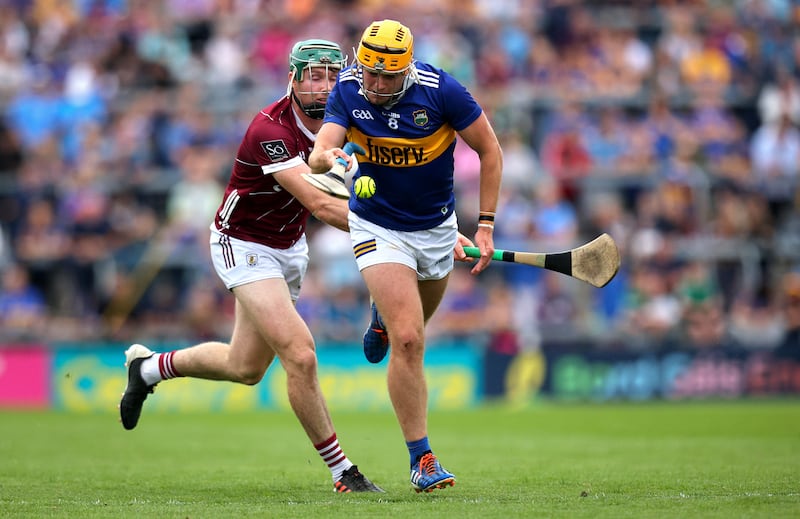To the surprise of most people watching, Saturday’s quarter-final between Galway and Tipperary came down to a late free. With his team two points behind, Tipp goalkeeper Rhys Shelly prepared to drop it in on the square and see if they could come up with a goal.
They didn’t and in retrospect why would they have? All evening they had been firing in hopeful ball to see if anything might stick and all evening Galway’s physically dominant and capable defenders had ensured it didn’t.
The mysterious thing about this match was that it was so close in the end. That gives some consolation to Tipperary, who were struggling for most of the 70 minutes, but even while their comeback brought them to within a point, Galway were still creating – and missing – chances for further scores.
During that period I was right in front of Even Niland, who played well and continues to improve, finding space to operate, and he had time to steady, take aim and fire a shot that flew wide.
Malachy Clerkin: The GAA should make more of St Patrick’s Day - and more of its intercounty stars
Shefflin trying to devise a way for Galway to halt Limerick juggernaut
Munster CEO defends broadcast coverage of province’s hurling championship
Sports Review 2023: Murphy’s incredible reflex save showed hurling’s facility for the impossible
I have frequently mentioned my surprise that many modern teams have so little flexibility. Here both teams surrendered the puck-out, especially Tipp, and both delivered largely poor ball into their forwards.
The critical difference is that Conor Whelan and Kevin Cooney were so good at winning sub-optimal distribution that Galway were able to win more of that 40-60 ball than Tipp managed against Gearóid McInerney and Daithí Burke.
Yet Tipperary continued to concede the puck-out to Galway. If you’re doing that and they are simply lamping it down to Whelan and Cooney, that’s surely a red flag. Is there a case to push up on everyone, including sweeper Cathal Mannion, and see how putting more pressure on the delivery works.
Teams rarely do that. Once set up to play a certain way they don’t seem to be willing or able to vary the approach. Surely there’s a need for variation – the ability to call a Plan B – to reverse the flow and momentum of a game, which on this occasion was running strongly against Tipperary.
So there was danger at the Galway end, albeit often unexploited, but not the same at the opposite end.
Compounding this were the wides. Both teams were wasteful but you could almost feel the air hissing out of Tipperary when Noel McGrath hit those three first-half wides in quick succession. They were winning very little on the inside forward line and now the attempts to compensate with long-range shooting was also coming unstuck in the crosswind.
Even in general play, they were getting obliterated at midfield where Joseph Cooney dominated the play.

Seven points for a Tipperary team in the first half? They can’t have been feeling good about themselves and although only three behind and still very much in it, it must have felt like double figures because Galway had squandered so many goals.
Galway absolutely went with Mannion as a sweeper. They tried it in the Leinster final but the effect was almost half-hearted. On Saturday, Henry Shefflin’s marked ambition was that they were not going to concede the goals that had undone them in the Leinster final and which had been Tipperary’s most obvious threat. And they didn’t.
For Tipperary, Shelly was brilliant in goal and Ronan Maher hit plenty of ball but not many Tipp players would have been happy.
All of the signs – passive concession of restarts and lack of energy – were on show in the Waterford defeat and it now appears that the cakewalk against Offaly was camouflage rather than evidence of a return to form.
Liam Cahill mentioned the need to ‘freshen things up’ and he will know that for all their competitiveness in Munster, when the revs went up outside the province, the engine couldn’t take it.
Galway can be very happy with where they now are. Again they’re going into a semi-final against Limerick but in far better shape than last year when they simply didn’t turn up for the Leinster final and after the quarter-final had people focusing more on Cork’s mistakes.
This time they have played well without getting full reward or perhaps ridding themselves of all self-doubt. If one day they do, it will be lights out for someone.
Clare are in a similar situation. In the first quarter-final against Dublin, they looked much improved on the exhausted team that turned up against Kilkenny nearly a year ago. Tony Kelly got a nice few scores and Mark Rodgers again impressed, taking over seamlessly on the frees and scoring another goal.
Two caveats were firstly, how poor Dublin were. Their touch was bad and although they battled well for half an hour despite the demoralising early loss of Dónal Burke – Clare’s unopposed march from 2-5 to 4-8 in a few minutes at the end of the first half ended the contest.
Secondly, injuries are now a worry for Brian Lohan. He went into this missing Conor Cleary, David McInerney and Aidan McCarthy and worryingly then lost John Conlon and Shane O’Donnell. They’ll need to be as close to full strength as possible, as they discovered in Conlon’s absence last year.
At full strength, they will be far readier for Kilkenny this time.
















